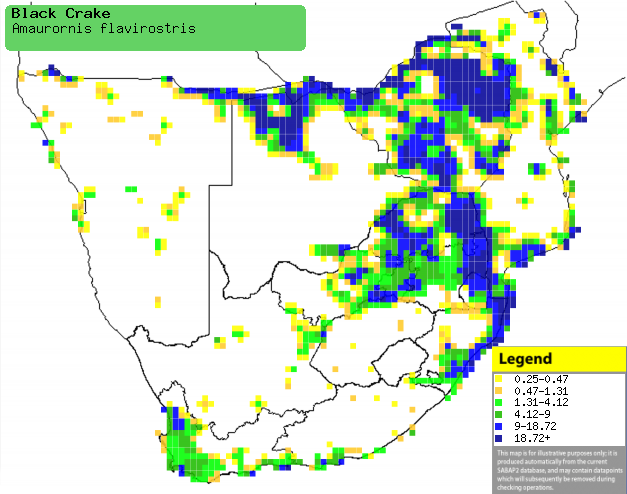|
Porzana flavirostra
(Black crake)
Swartriethaan [Afrikaans]; umJekejeke, umJengejenge
[Zulu]; Katukutuku (generic term for crake) [Kwangali]; Nhapata (generic
name for coot, gallinule, moorhen, crake or rail) [Shona]; Hukunambu,
Nkukumezane [Tsonga]; Zwart poseleinhoen [Dutch]; Râle à bec jaune
[French]; Mohrenralle, Negerralle [German]; Franga-d'água-preta
[Portuguese]
Life
> Eukaryotes >
Opisthokonta
> Metazoa (animals) >
Bilateria >
Deuterostomia > Chordata >
Craniata > Vertebrata (vertebrates) > Gnathostomata (jawed
vertebrates) > Teleostomi (teleost fish) > Osteichthyes (bony fish) > Class:
Sarcopterygii (lobe-finned
fish) > Stegocephalia (terrestrial
vertebrates) > Tetrapoda
(four-legged vertebrates) > Reptiliomorpha > Amniota >
Reptilia (reptiles) >
Romeriida > Diapsida > Archosauromorpha > Archosauria >
Dinosauria
(dinosaurs) > Saurischia > Theropoda (bipedal predatory dinosaurs) >
Coelurosauria > Maniraptora > Aves
(birds) > Order: Gruiformes >
Family: Rallidae
Distribution and habitat
Occurs across much of sub-Saharan Africa; within southern
Africa it is common in northern Namibia
(including the Caprivi Strip), northern and south-eastern Botswana, Zimbabwe,
Mozambique, Swaziland and north-eastern and southern South Africa. It generally
prefers vegetation along the edge of wetlands, especially with rank grass,
sedges, Papyrus (Cyperus papyrus), reedbeds with Phragmites and
alien Spanish reed (Arundo donax), swamp thickets and bushes.
|
 |
|
Distribution of Black crake in southern Africa,
based on statistical smoothing of the records from first SA Bird Atlas
Project (©
Animal Demography unit, University of
Cape Town; smoothing by Birgit Erni and Francesca Little). Colours range
from dark blue (most common) through to yellow (least common).
See here for the latest distribution
from the SABAP2. |
Predators and parasites
- Predators
- of adults
- of chicks
- of eggs
Movements and migrations
Mainly sedentary, although it moves away from
wetlands if they dry up, returning if they flood again; it also can
make local movements in dry regions in response to rainfall.
Food
Omnivorous, feeding on invertebrates, plant matter and
small vertebrates, such as eggs, nestlings, fish and frogs. It does most of its
foraging by walking along muddy shores, plucking prey from the air, water and
from aquatic vegetation. The following food items have been recorded
in its diet:
- Animals
- invertebrates
- insects
- molluscs
- earthworms
- crustaceans
- vertebrates
- small fish
- frogs and tadpoles
- small birds (caught in mist nets)
- eggs and nestlings
- Plants
- seeds
- Lemna (duckweed)
- Nymphaea (water lilies)
Breeding
- Monogamous, cooperative solitary nester, establishing a territory by
calling and chasing away intruders.
- The nest (see image below) is a deep cup if dry grass, sedges, rushes
and other water plants, typically concealed in vegetation just above water,
sometimes with a canopy of reeds above it.
- Egg-laying season is from August-June, peaking from September-December in
the Western Cape and from January-February elsewhere.
- It lays 2-6 eggs, which are incubated by both sexes and sometimes
helpers for about 13-19 days,
- Each breeding pair rears two broods per breeding season, with the first
chicks learning to fly at about 35 days old, after which they help their
parents to raise another brood before becoming fully independent.
Threats
Not threatened.
References
-
Hockey PAR, Dean WRJ and Ryan PG 2005. Roberts
- Birds of southern Africa, VIIth ed. The Trustees of the John Voelcker
Bird Book Fund, Cape Town.
|
